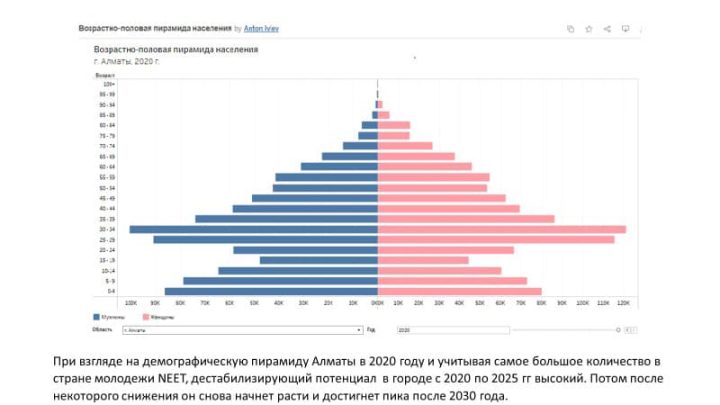Youth "Wave": Demography Allows to Foresee Social Tensions and Revolutions
 Photo: ult.kz
Photo: ult.kz
A growing population can turn into both vital human capital for a country and a huge challenge to a state's stability, scientists say.
Every year on July 11, World Population Day is celebrated. This holiday was established in 1990 at the initiative of the UN General Assembly in order to raise awareness of population issues, including their relationship to the environment and development.
Back in the 1960s, the rapid growth of the world's population became a serious concern for the United Nations. Last year, the 8 billionth inhabitant of the Earth appeared. Over the past hundred years, the human population has quadrupled despite the destructive wars and the flu pandemic. From 1950 to 2020, the number of people on the planet has more than tripled.
Such demographics are also becoming increasingly important in Kazakhstan, especially in the face of climate change, declining water supplies and an economic slowdown.
Aida Alzhanova, an expert on public administration and gender policy, shared how exactly population dynamics influence economic trends and political events and what status demographic science has in Kazakhstan.

According to her, in Kazakhstan, demographic science rests on the shoulders of a dozen and a half scientists and researchers working out of enthusiasm. This runs contrary to the situation in developed countries where demographic science is generously funded by the state and even by private structures. Indeed, knowing the prospects for the development of human resources is necessary.
On the interactive American site on world population, you can see forecasts for all states up until 2100. Kazakhstan lacks such resources.
There is a theory of the demographic "youth wave", which suggests the key role of the young population in radical forms of social protest and revolutions.
American political scientist Jack Goldstone has argued that periods of revolutions and large popular protests are associated with waves of demographic growth, and an increase in the proportion of young people in a population leads to the threat of social unrest, as such societies often face rampant unemployment and large groups of disaffected youth. These young people are more likely to be recruited into insurgent or terrorist groups. Countries with weak political institutions are most vulnerable to youth-related violence and social unrest.
The theory became very popular after the "Arab Spring", which caused damage to the economies of these countries (about $100 billion). Damage to the countries' development happened as well. Casualties also occurred. Similar situations on a reduced scale were in Zhanaozen and during Bloody January. Although in 2022 there was no “youth wave” in the country, it appeared in Almaty due to the high level of internal migration.
“I found the data thanks to enthusiastic scientists from the East Kazakhstan University, which is the center of scientific and demographic thought (although this science is not listed in our classifier), who calculated the population pyramids for all regions and cities of republican significance. If politicians used this convenient tool, they would have foreseen the impending catastrophe ,”
said Aida Alzhanova.
The highest birth rate in Kazakhstan's history occurred in 2021 - almost 450 thousand children.
“Is the government ready today to create all conditions for the development of a citizen of the future, competitive and economically sustainable? Is there a well-calculated plan for this over the years?”
the expert asks.
Aida Alzhanova is of the opinion that every year a child requires more and more needs to be satisfied. For example, safe birth, high-quality nutrition for the mother and child in the first year of life, a safe home environment, then nursery, and kindergarten. There should also be simultaneous preventive health care, art and sports clubs, a safe and friendly outdoor environment, protection from drugs, sexual exploitation, domestic violence, and bullying at school.
“According to my observations, there is no such plan! Judging by the fact that in the same 2021, first-graders were enrolled in the 1st grade Yu, means that the decision-makers “slept through” the fact that these children did not fly to us from Mars, but were born in 5-6 years before they went to school. This fact worries me very much, because in the future we will face a “youth wave”: in 2038, baby boomers will be 15 years old. By this time, we need to create an economy that can offer the necessary number of jobs to a huge mass of young people,”
the expert noted.
This is no easy task, however. Kazakhstanis who are currently not engaging in labor activity (people from 16 to 65 years old) make up almost half of the labor force (4.3 million people).

Original Author: Danil Utyupin
DISCLAIMER: This is a translated piece. The text has been modified, the content is the same. Please refer to the original piece in Russian for accuracy.
Latest news
- President Toqayev Sends Nazarbayev Birthday Wishes
- Toqayev Appoints New Ambassadors in Series of Diplomatic Changes
- Unidentified Object Resembling Drone Found in Atyrau Region
- Trump and Zelenskyy Discuss Air Defense Needs
- Rapper Qurt: Wife Withdraws Statement in Court
- Head of Azerbaijani Cultural Autonomy in Moscow Region Reportedly Loses Russian Citizenship
- Defense Secretary Hegseth Paused Ukraine Weapons Shipment Despite Pentagon Assessment — NBC
- Prosecutor General's Office Confirms Detention of Kozhamzharov's Associate in Torture Case
- State to Scale Back Role in Competitive Sectors
- Uzbek Banker Kidnapped in Paris
- Former Financial Police Officials Reportedly Detained, Case Concerns Torture
- Progress MS-31 Launches from Baikonur Carrying Fuel, Water, and Scientific Cargo
- Two Men to Face Trial for Homicide of Missing Atyrau Woman, Body Not Found
- Russia Launched Massive Strike on Ukraine Following Trump–Putin Call
- Rapper Qurt Accused of Abuse by Wife
- Pavlodar Region: Rescuers Seek Lower Retirement Age Amid Strain of Risky Work
- Businessman Vagif Suleymanov Detained in Moscow
- Kashagan Field Reaches One Billion Barrels of Oil Extracted
- Lenin Street in Osh Renamed After 19th-Century Kyrgyz Leader
- New Uranium Plant Launched in Turkistan Region with French Partnership

